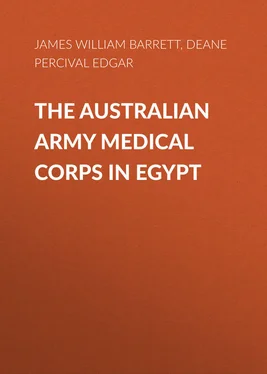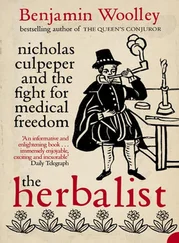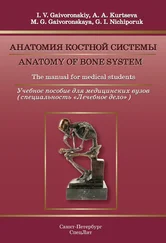Percival Deane - The Australian Army Medical Corps in Egypt
Здесь есть возможность читать онлайн «Percival Deane - The Australian Army Medical Corps in Egypt» — ознакомительный отрывок электронной книги совершенно бесплатно, а после прочтения отрывка купить полную версию. В некоторых случаях можно слушать аудио, скачать через торрент в формате fb2 и присутствует краткое содержание. ISBN: , Жанр: foreign_antique, foreign_prose, на английском языке. Описание произведения, (предисловие) а так же отзывы посетителей доступны на портале библиотеки ЛибКат.
- Название:The Australian Army Medical Corps in Egypt
- Автор:
- Жанр:
- Год:неизвестен
- ISBN:http://www.gutenberg.org/ebooks/41911
- Рейтинг книги:5 / 5. Голосов: 1
-
Избранное:Добавить в избранное
- Отзывы:
-
Ваша оценка:
- 100
- 1
- 2
- 3
- 4
- 5
The Australian Army Medical Corps in Egypt: краткое содержание, описание и аннотация
Предлагаем к чтению аннотацию, описание, краткое содержание или предисловие (зависит от того, что написал сам автор книги «The Australian Army Medical Corps in Egypt»). Если вы не нашли необходимую информацию о книге — напишите в комментариях, мы постараемся отыскать её.
The Australian Army Medical Corps in Egypt — читать онлайн ознакомительный отрывок
Ниже представлен текст книги, разбитый по страницам. Система сохранения места последней прочитанной страницы, позволяет с удобством читать онлайн бесплатно книгу «The Australian Army Medical Corps in Egypt», без необходимости каждый раз заново искать на чём Вы остановились. Поставьте закладку, и сможете в любой момент перейти на страницу, на которой закончили чтение.
Интервал:
Закладка:
As the equipment of additional beds involved the supply of all these articles, in addition to mattresses, blankets, linen, towels, kitchens, cooking-utensils, stoves, bedside tables, ward utensils, instruments, drugs, and bandages, the strain on the Quartermaster's department during this period of expansion was very great. The supply and distribution of food to the auxiliary hospitals occasioned considerable difficulty at the beginning of the crisis, but was satisfactorily adjusted.
As the patients became convalescent they were moved to one of the auxiliary hospitals, and from the auxiliary hospitals to one of the convalescent hospitals at Helouan or Alexandria, and thence either invalided or discharged to duty. As the patients during transference to the auxiliaries were conveyed in a motor ambulance, and when transferred to Helouan or Alexandria were motored to Cairo railway station under charge of a N.C.O., some idea of the work thrown on the motor ambulance corps and on the staff can be imagined.
So far all the auxiliary hospitals were regarded as wards of the main hospital, and administered from the main building – the only possible method of administration at this juncture. It was generally believed that the Dardanelles campaign would be of short duration, and that Luna Park and the other auxiliary hospitals would soon be closed. Consequently the expenditure of much money on these auxiliaries was deprecated. When, however, it became obvious that the operations at Gallipoli might last a very long time, and that in any event the troops pouring into Egypt from Australia and elsewhere would require hospital accommodation, an entirely new view of the matter was taken, and active steps were taken to permanently equip the auxiliary hospitals for more serious work. Of this equipment something must now be said in detail.
At Luna Park the central lake was emptied and drained, and was covered by an enormous shelter shed provided by the Australian Red Cross. The shelter with a modern kitchen provided by the authorities formed the dining-room for the patients, nearly all of whom were able to leave their beds. In addition an excellent operating-room was built in brick, barbers' shops were organised, and a canteen, store, and numerous comforts in the way of blinds, sunshades, punkahs, were provided. Ample bath and latrine accommodation was added. As time passed, the palm beds were gradually replaced by metal beds, and the total number reduced to 1,000. In the event of another emergency, beds can be again provided, to the number of 1,650, but such a step will only be taken in the presence of necessity.
Furthermore in the case of Luna Park and the other auxiliary hospitals, the D.M.S. Egypt decided that the feeding of patients should be effected by contract, and the matter was therefore left in the hands of a well-known caterer. A large amount of Red Cross money was expended on the shelter sheds and on a recreation hut managed by the Y.M.C.A., and Luna Park became an excellent open-air hospital. It is the more necessary to draw attention to this fact by reason of the adverse criticisms which have been passed by those who have only a superficial acquaintance with it. It will be sufficient to say that up to November 1, 5,500 patients had passed through it, and there had been only one death, and that from anæsthetic. This remarkable result was not altogether due to the fact that mild cases were admitted, for latterly many major operations had been performed, for appendectomy, etc., and according to Colonel Ryan, Consulting Surgeon to the Force in Egypt, all the operation cases had healed by first intention. In fact Luna Park really represents the triumph of the open-air method of treating patients in a rainless country. The patients preferred it because of the freedom the gardens gave them, but they showed one peculiarity which could never have been foreseen. The Australian soldier was not very fond of chairs. He did not want to stay in the shelter sheds, but preferred to spend much of his day lying in bed, and had to be ordered away from it to effect any change. It is not unnatural that men who have been doing excessive physical work should prefer physical rest when they can get it.
At No. 2 Auxiliary Hospital, the Atelier, similar changes were made. The Red Cross provided shelter sheds and a number of comforts. The Atelier was certainly the easiest of the buildings to adapt, by reason of the relatively small number of patients and its spacious surroundings.
At No. 3 Auxiliary Hospital the building could not accommodate more than 250 patients in any circumstances, but two large tennis courts were covered with matting and provided with a louvred roof. This proceeding was followed by the erection of wooden huts each of which constituted a ward of 50 beds. These huts were placed in convenient relationship to a central kitchen and other conveniences. The Sporting Club thus became an excellent outdoor hospital.
The creation of the Infectious Diseases Hospital at Abbassia is another instance of the importance of prevision. It was organised by Major Brown (who had already organised Luna Park and the Atelier) as a hospital of 250 beds. By successive squeezes, and by the erection of tents, the accommodation was rapidly increased to 1,250 beds, and was then insufficient although typhoid cases were not admitted.
The work of extension was at first difficult, but soon became quite simple because a considerable number of officers and men became experienced in the methods of effecting desirable results, and in the art of adapting means in sight to the end desired.
Finally it became obvious that the mechanism was becoming too complicated, i. e. that the administration of all these hospitals from the Palace Hotel, and the keeping of the records at the Palace Hotel, had become impossible. It was accordingly decided to separate them and make them independent commands. This arrangement was completed about the middle of August, but it involved a fresh crop of difficulties. It was quite necessary that some one should meet the trains and allot the patients to the various hospitals. That was a comparatively simple matter. It was necessary that the hospitals should be properly staffed, and that those who administered them should receive proper rank, in other words that there should be a definite establishment. This necessitated a reference to the Australian Government, and consequently difficulties and delays.
The valuable and almost essential part played by the Australian Branch British Red Cross, in effecting the expansion and in preventing a disaster, will be referred to in the chapter on the Red Cross.
The following table indicates the nature of the increasing demand on the hospital accommodation:

Largest number of patients admitted on any one day (June 8, 1915):
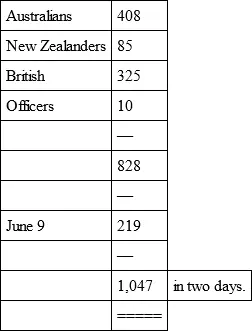
Sick and wounded received at the First Australian General Hospital at the end of April:
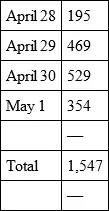
Surveying in retrospect this anxious and troublesome period, the outstanding feature is the mistake made in the constant assumption that the hospital expansion was temporary. It was stated that Luna Park would only be wanted for a few weeks; the Dardanelles campaign would soon be over, Luna Park would not then be wanted, and could be closed, consequently heavy expenditure on it was deprecated. Furthermore the experience gained makes it obvious that in war the Service cannot include too many medical officers – preferably juniors. The demand for their services here and there is practically unlimited. They should be young and unattached to any particular unit – in fact a junior reserve on the spot.
Читать дальшеИнтервал:
Закладка:
Похожие книги на «The Australian Army Medical Corps in Egypt»
Представляем Вашему вниманию похожие книги на «The Australian Army Medical Corps in Egypt» списком для выбора. Мы отобрали схожую по названию и смыслу литературу в надежде предоставить читателям больше вариантов отыскать новые, интересные, ещё непрочитанные произведения.
Обсуждение, отзывы о книге «The Australian Army Medical Corps in Egypt» и просто собственные мнения читателей. Оставьте ваши комментарии, напишите, что Вы думаете о произведении, его смысле или главных героях. Укажите что конкретно понравилось, а что нет, и почему Вы так считаете.
